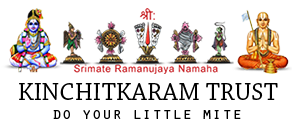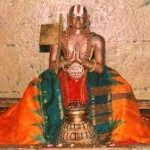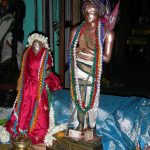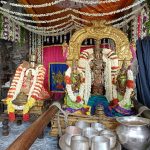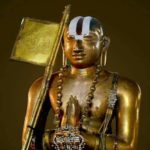Srimathe Ramanujaya Namaha,
Namaskaram Jayaram Swami,
With Acharya ThiruvAdi Bhalam and Ammangaar Abhimaanam and Velukkudi SriKrishnan Swami Aasirvadham, Adiyen would like to SHARE some details regarding the correct understanding of “Puruhsa” and “Karma kanda and Brahma kanda“.
Sri Velukkudi Krishnan Swami in Upanyasam says Vedas are split in to TWO called as:
‘1) PoorvA Bhaagam (1st portion) called as “Vedham (veda)” –> Karma Kaanda
‘2) UttharA Bhaagam (2nd portion) called as “Vedhantam (vedanta) which is nothing but the Upanishads”. –> Brahma Kaanda.
1) “Poorva Bhaagam (Karma Kaanda)” in Vedas tell primarily about Karma-Anushtanams, but DOESN’T FULLY REVEAL who is ParaBrahmam/ParaDevatha/ParamAthma. It only tells MAINLY that, if one do this particular yaagam/yagjyam, then the particular Phalam is given by that Particular Devatha. So, many people do that Karma-Anushtanams and follow each Devatha, since PoorvA-Bhaagam of Vedas doesn’t talk about PARA DEVATHA (எல்லா தெய்வத்துக்கும் மேம் பட்டவர் யார் , who is the ultimate leader for all Devathas).
Hence, Many small Sampradayam/Mathams exists due to those GURU’S/Matha Thalaivargal limit their knowledge by just reading/following only Poorva-Bhaagam of Vedas and doesn’t go beyond to learn the Uttara-Bhaagam of Vedas. Hence, they live in confused state and their followers as well, without knowing who is actual BhagavAn/ParamAthma/ParaBrahmam/ParaDevatha as per Vedas.
2) “Uttara Bhaagam (Brahma Kaanda)” in Vedas is called “Upanishads/Vedhantam” which explains in detail meaning the ESSENCE OF VEDAS/SHASTRAS which TALKS ONLY ABOUT “BhagavAn Sriman Narayanan” as ParamAthma/ParaBrahmam/ParaDevatha and all other Jeevathmas (either in human body or Deva body like Brahma, Shiva, Indra etc) are SHESHAN (Servant) to Supreme SHESHI “BhagavAn Sriman Narayanan”.
*********************
PoorvAcharyas provide an “Marriage Analogy” example for the Poorva-Bhaagam & Uttara-Bhaagam of Vedas as below.
1) Poorva-Bhaagam of Vedas –> A Bride searching for one Bride-groom. Basically the parents looking many male photos before the women choses one Bride-groom. Which means, a JeevAthma not sure who is ParaBrahmam (final Bride-groom) as per Shastras/Vedas, so goes and prays all Devathas like Brahma, Shiva, Indra, Agni, Varuna etc.. including the ParaBrahmam Sriman Narayanan.
This state is “future SiVaishavaite” situation.
2) Uttara Bhaagam of Vedas –> A Bride (BhaddAthma) finally filters and decides/understands her One-and-Only bride groom (Supreme Sriman NarayanA) and get married to HIM and Trashes the remaining photos of other males (devatas) whom she didnot chose, since it in not necessary to keep the other male photos while the bride was deciding whom to get legally married as a “Pathi-Vratha Sthree” . So, Trashing the photos of other male photos after choosing One Bride groom is NOT disrespecting the other males.
This state is “SriVaishavaite” lakshanam of a Sharanagathan. TRUE NATURE OF ANY JEEVATHMA for NithyaKainkaryam and Moksham.
Moreover Sriman NarayanAn is the ONLY PUrushotthaman (MALE) and all other JeevAthmas are FEMALES in Deva Body like Brahma, Shiva, Indra, Agni, etc….including us in human bodies…..
So, out of ignorance, if a “future SriVaishnavaite” tell a “SriVaishnaviate” to pray other Devathas since Vedas says, we should just ignore them or enlighten them based on the higher level section of Vedas “Brahma Kaanda”. We are wise and one doesn’t say to someone’s wife to look at other male in the same way as she look at her Husband, then how come some say very Easily about the Spiritual Husband-Wife relationship. So, we can refrain from loose talks and Enlighten them more based on EXACTS (Swami’s Pravachanams).
***************
Next about PURUSHA (पुरुष)
meaning is “Puru Bahu Sanoti” Ithi Purushaha (One who gives bliss is Purusha,வரம் கொடுப்பவன் புருஷன் )
Puru means Plenty,
Sanoti means act of giving
So a devata or ParamAthma both give varam and can be called Purusha as per the Etimology, but devatas give varam based on their limited capability since they raw the ability by begging SUpreme Personality Sriman NarayanA whose ABILITY is ABUNDANT.
For this we need to understand the Tatva Trayam
‘1) One ParamAthma,
‘2) Countless Chit (Sentient JeevAthmas)
‘3) Countless Achit (Insentient Jada Porul)
Again ‘2) “Chit” is classified into three types ,
‘2 a), BhaddAthma : JeevAthmas covered with Karmas, Vaasanaas, Ruchi, Avidhya, Prakruthi Sambhandham. All those in Samsaram (this side of VirajAI River) like Brahma, Shiva, Indra, Agni, Varuna, humans etc…..
‘2 b) MukthAthma : Same above BhaaAdthmas named as MukthAthmas after reaching MOksham (other side of Virajai river),
‘2 c) NithyAthma : Those JevAthmas who have NEVER HAD KARMA VAASANAAS of Samsaram. Hence, they are called “Asprishta Samsara Gandhargal (a.k.a Nithya Sooris) like Vishvaksenar, Garuda, Aadhisheshan.
Now for these five classifications they are also called as Purushas as below:
- Achit = Apurusha (Not a Purusha),
- Chit (BhaddAthma) : Purusha,
- Chit (MukthAthma) : Uth Purusha,
- Chit (NithyAthma) : Uttara Purusha,
- ParamAthma : Uttama Purusha
So Karma Kaanda of vedas (Rik, Yajur etc..) talks lot of “Purusha” means as they talk about “BhaddAthmas”. like Trapped JeevAthmas with Karmas on Deva Bodies (Devathas). It also talkes about Uttama Purusha, but very less.
However, Brahma Kaanda (Upanishds/Vedantham) deals with ParamAthma (Uttama Purusha) SUPREME PERSONALITY.
BhagavAt Gita is essence of Upanishads in which SUPREME SriKrishna declares HIMSELF as UTTAMA Purusha in BG 15 sloka 17 as below.
उत्तम: पुरुषस्त्वन्य: परमात्मेत्युदाहृत: |
यो लोकत्रयमाविश्य बिभर्त्यव्यय ईश्वर: || 17||
uttamaḥ puruṣhastvanyaḥ paramātmety udāhṛitaḥ
yo loka-trayam āviśhya bibharty avyaya īśhvaraḥ
So looking at word Purusha in Karma Kaanda (Rik etc..), we should not get carried away that Vedas recommend everyone to pray devatas. It is to be understood as those sections are meant for those at lower level Gyana followers of Karma Kaanda, since “Purusha” word is common and context sensitive in the sentences where it is used.
So, wherever in karma kaanda it says Purusha did the Creation of the word, it is to be understood that Utthama Purusha did the creation and not to confuse with devataas.
We discussed in details about Advaraka Shristi (Primary Creation by Sriman NarayanA) and Sadvaraka Shristi (Secondary creation handed over to JeevAthma Brahma) in details with refernce from PoorvAchayas Granthmas. People who are listening or reading general online texts like Srimadh BhagvAtam may not find these Swapdesa (In-Depth secret teachings). SO one has to listen to Swami’s Kalakshepam “Yathindra Mata Deepika” for these.
Swami Ramanuja BHagavAn’s Shristi Procedure | Dharma Sandeha (kinchit.org)
Adiyen (ElayaAlwar) Srinivasa (DhoddayAcharyAr) Dasan,
UYYA ORAEY VAZHI UDAYAVAR THIRUVADI,
Sarvam SriKrishnarpanam Asthu
